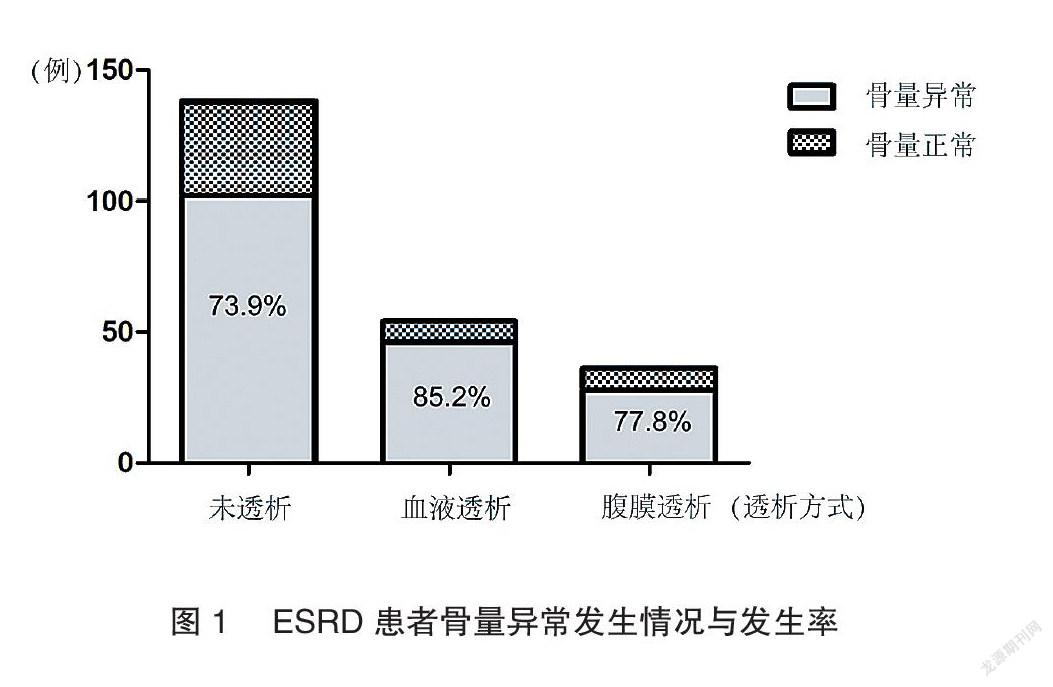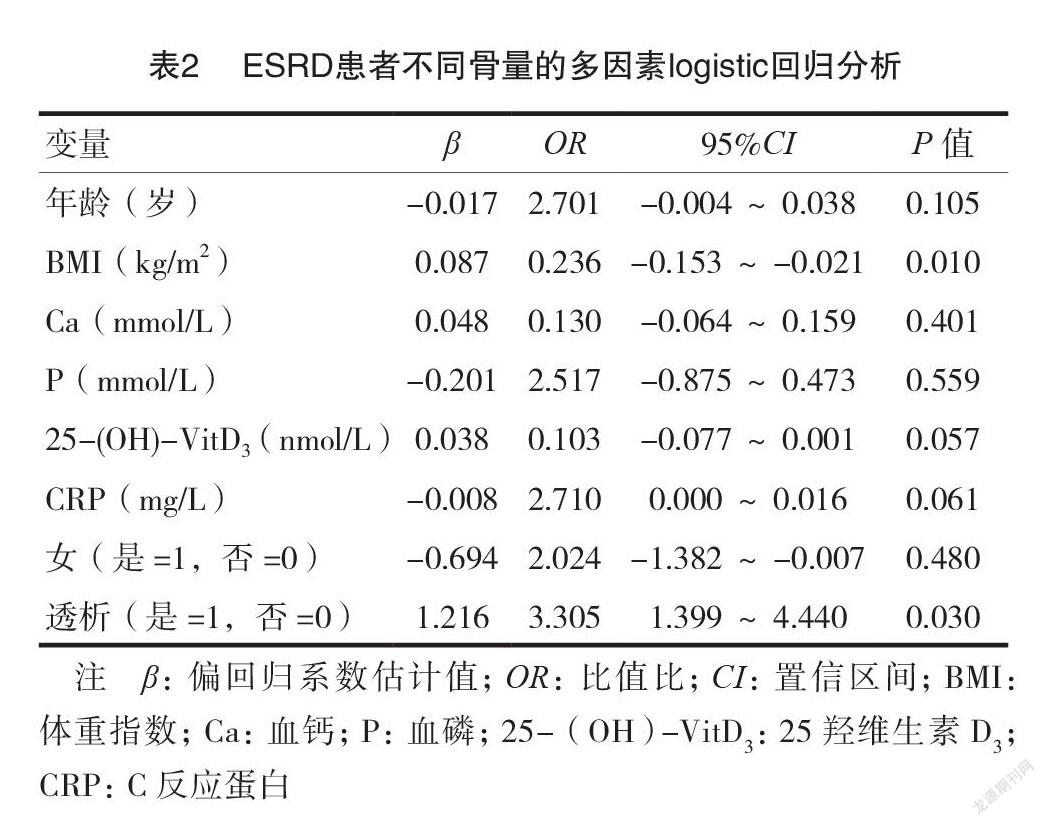单中心终末期肾脏病患者骨量异常的危险因素分析
生玉平 马晓迎 杨星梦 张浩然 王娜 徐海平 孙福云



[摘要] 目的探讨终末期肾脏病(ESRD)患者骨量异常的危险因素。方法纳入2020年 1—12月在沧州市中心医院肾内科住院的228例 ESRD 患者为研究对象,收集临床资料及化验指标,采用双能 X 线吸收测定法检测骨密度(BMD)及确定 T 值。依据 T 值分为骨量正常组和骨量异常组,骨量异常组包括骨量减少组和骨质疏松组。比较各组年龄、性别、透析龄、是否透析、体重指数(BMI)、血钙(Ca)、血磷(P)、甲状旁腺激素(iPTH)、碱性磷酸酶(ALP)、25羟维生素 D3[25-(OH)-VitD3]、C 反应蛋白(CRP)的差异,并行 logistic 回归分析骨量异常的危险因素。结果所有患者骨量异常的发生率高达77.2%;透析患者骨量异常发生率(82.2%)高于非透析患者(73.9%)。各組患者在年龄、性别、BMI、Ca、P、25-(OH)-VitD3、 CRP 方面比较,差异有统计学意义(均 P <0.05);透析患者比例随骨量下降有升高趋势,但差异无统计学意义( P=0.058)。将 P <0.1的因素纳入有序多因素 logistic 回归分析,发现透析( OR=3.305,95%CI 为 1.399~ 4.440, P=0.030)、低 BMI(OR=0.236,95%CI 为-0.153~ -0.021, P=0.010)是 ESRD 患者骨量异常的危险因素。结论透析患者骨量异常发生率高于非透析患者。透析、低 BMI 是 ESRD 患者骨量异常的独立危险因素,但预测价值有待进一步评估。
[关键词] 终末期肾脏病;骨密度;骨量异常;骨质疏松;危险因素
[中图分类号] R692.5 [文献标识码] A [文章编号] 2095-0616(2022)06-0023-05
A single centered analysis on risk factors for abnormal bone mass in patients with end-stage renal disease
SHENG Yuping MA Xiaoying YANG Xingmeng ZHANG Haoran WANG NaXU Haiping SUN Fuyun
Department of Nephrology Ⅱ ,Cangzhou Central Hospital, Hebei, Cangzhou 061000, China
[Abstract] Objective To investigate the risk factors for abnormal bone mass in patients with end-stage renal disease (ESRD). Methods A total of 228 patients with ESRD who were hospitalized in the Department of Nephrology at Cangzhou Central Hospital from January to December 2020 were included in the study, and their clinical data and laboratory indexes were collected. The bone mineral density (BMD) was detected and the T value was determined by dual-energy X-ray absorptiometry. Based on the T value, the patients were divided into the normal bone mass group and the abnormal bone mass group, and the abnormal bone mass group was further divided into the reduced bone mass group and the osteoporosis group. The differences in age, gender, dialysis age, the presence or absence of dialysis, body mass index (BMI), blood calcium (Ca), blood phosphorus (P), intact parathyroid hormone (iPTH), alkaline phosphatase (ALP), 25 hydroxyvitamin D3 [25-(OH)-VitD3], and C-reactive protein (CRP) were compared among all groups, and logistic regression was performed to analyze the risk factors for abnormal bone mass. Results The incidence of abnormal bone mass was up to 77.2% in all patients, and the incidence of abnormal bone mass in dialysis patients (82.2%) was higher than that in non-dialysis patients (73.9%). There were statistically significant differences in age, gender, BMI, Ca, P, 25-(OH)-VitD3, and CRP among all groups (all P <0.05). The proportion of dialysis patients tended to increase with decreasing bone mass, but there was no significant difference (P=0.058). Factors with P <0.1 were included in the multivariate ordered logistic regression analysis, and the results showed that dialysis (OR=3.305, 95%CI:1.399 to 4.440, P=0.030) and low BMI (OR=0.236, 95%CI:-0.153 to -0.021, P=0.010) were risk factors for abnormal bone mass in patients with ESRD. Conclusion The incidence of abnormal bone mass in dialysis patients is higher than that in non-dialysis patients. Dialysis and low BMI are independent risk factors for abnormal bone mass in patients with ESRD, but the predictive value needs to be further evaluated.
[Key words] End-stage renal disease; Bone mineral density; Abnormal bone mass; Osteoporosis; Risk factors
骨质疏松是一种以骨量减低、骨微结构破坏、骨脆性增加为特征的全身性代谢性疾病[1]。骨密度(bone mineral density, BMD)是体现骨量的重要参数,也是反映骨强度的最主要标准[2]。改善全球肾脏病预后组织2017年提出的关于慢性肾脏病- 矿物质和骨代谢紊乱的指南建议用 BMD 来评估慢性肾脏病(chronic kidney disease,CKD)的骨折风险[3]。有研究已证实[4-5],BMD 可预测透析患者的骨折风险和死亡率。
CKD 是骨质疏松强烈而独立的危险因素[6]。它不仅使骨质疏松患病率增加[7],同时与骨折风险及骨折后死亡率相关[8-9]。近年来的研究人群局限于 CKD 各期患者之间[10]、CKD 患者与健康人群之间[8] 以及透析患者与健康人群之间[11-12]。本研究将目标人群锁在终末期肾脏病(end-stage renal disease, ESRD)患者,包括透析(血液透析和腹膜透析)患者以及非透析患者,对骨量异常患病情况及危险因素进行分析。
1 资料与方法
1.1 研究对象
纳入标准:采用 CKD-EPI 公式估算肾小球滤过率(glomerular filtration rate, eGFR),依据2002年美国肾脏病基金会提出的 CKD 分期标准[13],符合 CKD 5期即 eGFR<15 ml/min。排除标准:急性肾损伤、CKD 急性加重、严重感染、恶性肿瘤、多发性骨髓瘤、长期应用糖皮质激素及数据缺失的患者。纳入患者共256例,排除急性肾损伤2 例、CKD 急性加重4 例、严重感染5 例、多发性骨髓瘤3 例、长期应用糖皮质激素3 例、数据缺失11例,最终纳入228例。年龄19~ 84岁,男137例(60%),透析患者 90例(血透60%),中位透析龄36个月。本院双能 X 线骨密度仪检测并记录患者的第1 ~5 腰椎 BMD 值,此数值与参考值的平均值比较,所得的标准差用 T 值表示。依据世界卫生组织制定的骨质疏松 BMD 测量的诊断标准[14],T ≥-1.0为骨量正常,-2.5< T <-1.0为骨量减少, T ≤-2.5为骨质疏松。依据T 值患者被分为骨量正常组和骨量异常组,骨量异常组包括骨量减少组和骨质疏松组。本研究符合医院医学伦理学标准,经我院医学伦理委员会批准(审批号:2020-257-01),所有入选患者均知情同意。
1.2 研究方法
臨床资料及标本收集:记录患者的年龄、性别、身高、体重、透析龄、透析方式等,所有患者均于住院后第2 天清晨空腹采血,检测指标血钙(calcium,Ca)、血磷(phosphorus, P)、甲状旁腺激素(parathyroid hormone,iPTH)、碱性磷酸酶(alkaline phosphatase,ALP)、25羟维生素 D3[25 hydroxy vitamin D3,25-(OH)- VitD3]、C 反应蛋白(C-reactive protein, CRP)。计算体重指数(body mass index, BMI)[BMI(kg/m2)=体重(kg)/身高(m)2]。在白蛋白(albumin,ALB)<40 g/L 时对 Ca 进行校正,公式为:校正钙(mmol/L)=测量钙值(mmol/L)+[40-ALB(g/L)]×0.02。
1.3 统计学方法
采用 SPSS 24.0统计学软件进行统计分析。正态分布的计量资料以均数± 标准差(x ±s)表示,多组比较采用方差分析。非正态分布的计量资料用 M(P25, P75)表示,多组间比较采用 Kruskal- wallis秩和检验。计数资料以[n (%)]表示,有序计数资料多组比较采用 Kruskal-wallis秩和检验。采用有序多因素 logistic 回归分析 ESRD 患者骨量异常的危险因素。 P <0.05为差异有统计学意义。
2 结果
2.1 ESRD患者骨量异常发生情况与发生率
共入组患者228例,骨量异常(176例)总发生率为77.2%。其中,非透析患者(138例)骨量异常发生率为73.9%,透析患者(90例)骨量异常发生率为 82.2%。透析患者中血透患者(54例)骨量异常发生率为85.2%,腹透患者(36例)骨量异常发生率为 77.8%。可见透析患者比非透析患者骨量异常发生率高,而血液透析患者较腹膜透析患者骨量异常发生率高。见图1。
2.2 ESRD患者不同骨量资料比较
与骨量正常组相比,骨质疏松组年龄更大(P <0.05),骨量疏松组女性比例更高(P <0.05),骨质疏松组 25-(OH)-VitD3 更低(P <0.05); BMI、P 随骨量下降而降低(均 P <0.05); CRP、Ca 随骨量下降而升高(均 P <0.05);透析患者比例随骨量下降有升高趋势,但差异不明显( P=0.058);透析龄、iPTH、ALP 随骨量下降有升高趋势,但差异均无统计学意义( P >0.05)。见表1。
2.3 ESRD患者不同骨量的多因素logistic回归分析
以 BMD 为因变量,结合上述 P <0.1的因素,纳入年龄、性别、BMI、CRP、Ca、P、25-(OH)-VitD3 以及是否透析行有序多因素 logistic 回归分析,结果显示透析、低 BMI 是 ESRD 患者骨量异常的独立危险因素(均 P <0.05)。见表2。
3 讨论
本研究发现透析是 ESRD 患者骨量异常的独立危险因素。就目前研究而言,透析是否与 BMD 相关是有争议的。有些研究与本研究结果相一致,发现透析与 BMD 呈负相关。有研究表明[15],与健康人群相比,透析患者的 BMD 损失进展似乎更大。 Melton 等[16]发现血液透析患者的 BMD 损失比健康人群高7 ~14倍。也有结果不一致的研究,如Jamal 等[6]研究发现 BMD 与是否透析没有显著关系。透析本身可能会加重 BMD 减低的原因目前尚不明确。有研究发现[17]血液透析可清除破骨细胞分化因子(receptor activator of NF-κB ligand, RANKL),却极少清除骨保护素(oculopneumoplethysmo graph, OPG),导致 RANKL/OPG 显著下降,从而引发破骨细胞活化、骨质破坏,进一步引起骨质疏松。另外,有研究发现[18],炎症因子增加可通过诱导巨噬细胞集落刺激因子(macrophage- colony stimulating factor,M-CSF)和 RANKL 的表达,促进破骨细胞分化增殖、抑制成骨细胞成骨,从而造成骨量流失。这提示可能与透析患者存在的微炎症状态有关。本研究发现 CRP 虽不是独立危险因素,但随骨量下降而升高,差异有统计学意义,也间接表明了这一点。总之,透析如何影响骨量异常,原因机制还需进一步研究。
本研究发现低 BMI 是 ESRD 患者骨量异常的危险因素。这与 Castillo 等[19]、张默等[20]学者研究结果相符。Amemiya等[21]研究发现低 BMI 可能是 ESRD 和维持性透析患者致骨质疏松的危险因素,且同身高相比,与体重的关系更大。有研究认为[22],其原因与肥胖减少承重骨的骨量流失,负重刺激骨的形成,增加雄激素向雌激素的转化相关。但有学者发现[23],在非 CKD 的超重和肥胖患者(BMI >24 kg/m2)中, BMI 越高骨量反而降低。因此, BMI 可能在一定范围内对骨量异常是保护因素,具体范围还需进一步研究。
本研究中骨代谢相关指标方面仅发现 25-(OH)-VitD3在骨质疏松组较另两组更低,差异有统计学意义。这与一项回顾性研究[24]结果是一致的,其发现 ESRD 患者的活性维生素 D<15 nmol/L 时,骨形成率和骨小梁矿化表面积均减少。另一项研究[25]显示,维持性血液透析患者活性维生素 D 缺乏时,骨折的发生率明显增加。因此,活性维生素 D 的缺乏与骨质疏松的发生密切相关。本研究发现 P 随骨量下降而降低, Ca 随骨量下降而升高,iPTH、ALP 随骨量下降有升高趋势,但均不是骨量异常的独立危险因素,这与已有研究结果一致[26-28]。这些指標并没有因不同程度的骨量异常而体现出明显不同,表明 ESRD 骨病的病理生理是复杂的,并不仅仅取决于某个指标的水平。
作为单中心的一个横断面研究,所得结果受到较多干扰因素的影响,如样本量不够大、各组间匹配不够均衡、时间短、分层不够等,从而使得危险因素的预测价值有待进一步评估。
综上所述,本研究的一些发现提示可以通过提高透析质量、改善营养状况等措施来提高 BMD,降低骨量异常的发生率,进而减少骨质疏松患病率及骨折发生风险。
[参考文献]
[1] Brown JP,Josse RG.2002 clinical practice guidelinesfor the diagnosis and management of osteoporosis in Canada[J].CMAJ,2002,167(10 Suppl):S1-S34.
[2] Assessment of fracture risk and its application to screeningfor postmenopausal osteoporosis.Report of a WHO Study Group[J].World Health Organ Tech Rep Ser,1994,843:1-129.
[3] Ketteler M,Block GA,Evenepoel P,et al.Executivesummary of the 2017 KDIGO Chronic Kidney Disease- Mineral and Bone Disorder (CKD-MBD) Guideline Update: what's changed and why it matters[J].Kidney Int,2017,92(1):26-36.
[4] Bucur RC,Panjwani DD,Turner L,et al.Low bonemineral density and fractures in stages 3-5 CKD: an updated systematic review and meta-analysis[J]. Osteoporos Int,2015,26(2):449-458.
[5] Chen Z,Qureshi AR,Ripsweden J,et al.Vertebralbone density associates with coronary artery calcification and is an independent predictor of poor outcome in end- stage renal disease patients[J].Bone,2016,92:50-57.
[6] Jamal SA,Swan VJ,Brown JP,et al.Kidney functionand rate of bone loss at the hip and spine: the Canadian Multicentre Osteoporosis Study[J].Am J Kidney Dis,2010,55(2):291-299.
[7] Shin JH,Kim SH,Yu SH.Metabolic syndrome andchronic kidney disease as risk factors of osteoporosis[J]. Clin Nephrol,2014,81(1):1-8.
[8] Coco M,Rush H.Increased incidence of hip fractures indialysis patients with low serum parathyroid hormone[J]. Am J Kidney Dis,2000,36(6):1115-1121.
[9] Yenchek RH,Ix JH,Shlipak MG,et al.Bone mineraldensity and fracture risk in older individuals with CKD[J]. Clin J Am Soc Nephrol,2012,7(7):1130-1136.
[10] Stompor T,Zablocki M,LesiowM.Osteoporosis inmineral and bone disorders of chronic kidney disease[J]. Pol Arch Med Wewn,2013,123(6):314-320.
[11] Young EW,Akiba T,Albert JM,et al.Magnitude and
impact of abnormal mineral metabolism in hemodialysis patients in the Dialysis Outcomes and Practice Patterns Study (DOPPS)[J].Am J Kidney Dis,2004,44(5 Suppl 2):34-38.
[12] Wakasugi M,Kazama JJ,Taniguchi M,et al.Increased risk of hip fracture among Japanese hemodialysis patients[J].J Bone Miner Metab,2013,31(3):315-321.
[13] National Kidney Foundation.K/DOQI clinical practiceguidelines for chronic kidney disease: evaluation, classification, and stratification[J].Am J Kidney Dis,2002,39(2 Suppl 1):S1-S266.
[14] Lewiecki EM,Watts NB.New guidelines for theprevention and treatment of osteoporosis[J].South Med J,2009,102(2):175-179.
[15] Avramovski P,SikoleA.The progression of bonemineral density loss in dialysis patients compared with the general population[J].Korean J Intern Med,2012,27(4):436-442.
[16] Melton LR,Khosla S,Atkinson EJ,et al.Cross-sectional versus longitudinal evaluation of bone loss in men and women[J].Osteoporos Int,2000,11(7):592-599.
[17] Gonnelli S,Montagnani A,Caffarelli C,et al.Osteoprotegerin (OPG) and receptor activator of NF-kB ligand (RANK-L) serum levels in patients on chronichemodialysis[J].J Endocrinol Invest,2005,28(6): 534-539.
[18] 左彥波,贾娟,王红杰. 慢性肾脏病骨质疏松发病机制的研究进展[J].医学研究与教育,2019,36(4):10-18.
[19] Castillo RF,de la Rosa RJ.Relation between body mass index and bone mineral density among haemodialysis patients with chronic kidney disease[J].J Ren Care,2009,35 Suppl 1:57-64.
[20] 张默,刘林林,王力宁,等 . 影响维持性血液透析患者骨密度相关因素分析 [J]. 中国骨质疏松杂志,2016,22(11):1446-1450.
[21] Amemiya N,Otsubo S,Iwasa Y,et al.Association between high-molecular-weight adiponectin and bone mineral density in hemodialysis patients[J].Clin Exp Nephrol,2013,17(3):411-415.
[22] Takata S,Ikata T,YonezuH.Characteristics of bone mineral density and soft tissue composition of obese Japanese women: application of dual-energy X-ray absorptiometry[J].J Bone Miner Metab,1999,17(3):206-210.
[23] Nielson CM,Marshall LM,Adams AL,et al.BMI and fracture risk in older men: the osteoporotic fractures in men study (MrOS)[J].J Bone Miner Res,2011,26(3):496-502.
[24] Coen G,Mantella D,Manni M,et al.25-hydroxyvitamin D levels and bone histomorphometry in hemodialysis renal osteodystrophy[J].Kidney Int,2005,68(4):1840-1848.
[25] Ambrus C,Almasi C,Berta K,et al.Vitamin D insufficiency and bone fractures in patients on maintenance hemodialysis[J].Int Urol Nephrol,2011,43(2):475-482.
[26] Bansal A,Sandhu G,Chitale RA,et al.Effect of lower calcium dialysate on laboratory abnormalities in chronic kidney disease-associated mineral and bone disorder[J].Am J Ther,2012,19(6):429-431.
[27] Brunerova L,Kasalicky P,Veresova J,et al.Loss of bone mineral density and trabecular bone score in elderly hemodialysis patients: a 2-year follow-up, prospective, single-centre study[J].Int Urol Nephrol,2020,52(2):379-385.
[28] Waziri B,Duarte R,Naicker S.Chronic Kidney Disease-Mineral and Bone Disorder (CKD-MBD): Current Perspectives[J].Int J Nephrol Renovasc Dis,2019,12:263-276.
(收稿日期:2021-10-09)

